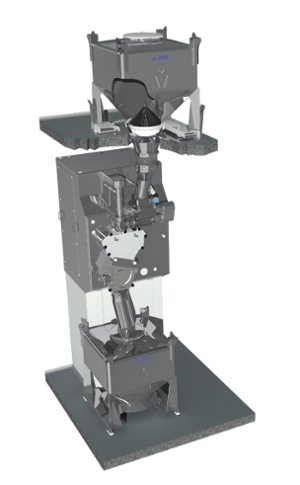When setting up a new manufacturing line or facility, for each processing stage considerable energy is spent in choosing the right pharmaceutical equipment to ensure that you can produce a quality tablet or capsule every time. Without it you won’t have regulatory approval and gain the licence to produce. In our experience, the materials handling part of the manufacturing process can get overlooked at this stage. If you have opted to conduct ‘dry granulation’ using a roller compactor as your manufacturing method, then it is vital to get the feed of material correct as this is the last point at which you lock the chemistry into the powder. In this blog we discuss the options to help you choose which would best suit your manufacturing needs.
Some people consider IBCs to be commodity items without process significance and are generally left until the latter stage of a project to be purchased. By which time there could well be overspends which will impact on the available budget for the material handling systems. Once it’s importance on the wider process is understood the material handling budget can be allocated/ring-fenced early one to avoid any problems down the line.
It is well recognised within the industry that core flow can lead to segregation and that simple butterfly or slide valve IBCs can be a contributing factor. If using large volume IBCs with these same valves, then bridging of product can also be an issue as there is no mechanism by which the IBC can promote flow.
Roller Compaction and Granulation Overview
Roller compaction or dry granulation is a relatively simple process of pressing fine powders between two counter rotating rollers to form a compact solid/sheet. This process removes the requirement for additional binders or liquids, which are necessary in the wet granulation process, thereby making it a more cost effective manufacturing methodology for some molecules. As manufacturers face more competition they are looking for ways to reduce capital expenditure and operating costs.
Although a relatively straight forward process, feeding the powder in to the roller compactor is a vital step in the production of granules. There are many ways to feed the roller compactor whether by vacuum/pneumatic conveying or container systems, but here we are considering the different types of container system.
For more in-depth information we explored the use of conveying systems in this white paper.
The two most popular types of containers are butterfly valve or Cone Valve IBCs.
Feeding with Butterfly Valve
This is not always the ideal solution for the pharmaceutical industry for the following reasons:
- Risk of Core Flow being created which results in the possibility of mix segregation. If the mix segregates, then the granules created won’t be uniform and there will be a poor finished product.
- Risk of bridging/blockage which means product won’t flow out of the IBC which will be inefficient leaving the roller compactor waiting for product delivery.
- Risk of compaction in chutes/hoppers so again product gets stuck and inconsistent flow results in poor product quality or scrapped batches.
- The lack of flow from the IBC requires operator intervention and the use of physical force may be required resulting in bin rash or separation of the ingredients if too much vibration is used (Please also read our blog on reducing bin-rash during powder flow).
Feeding with the Matcon Cone Valve
This is a better choice of pharmaceutical equipment maintaining optimum particle size distribution and density for the mixed material waiting to be fed to the Roller Compactor. The Matcon Cone Valve technology reduces segregation while controlling flow for oral dosage manufacturing. The Cone Valve is a more advanced feeder to roller compaction:
- Mass Flow is created which overcomes Segregation Issues (to find out more go to a previous blog of ours - “Quality issues of segregation…”).
- Reliable and Consistent Feeding so the Roller Compactor can work efficiently
- No Risk of Bridging/Blockage in the Cone Valve IBC
- No requirement for additional operator intervention as product will flow consistently and steadily (Read one of our previous blogs - “How to get control of free-flowing powders…”)

Why Choose Matcon IBCs
From the wide variety of sizes, compatible with other pharmaceutical equipment from filling to mixing to feeding to roller compactor and on to tablet pressing or capsule filling, these containers are flexible and easy to clean. The key factor which ensures Matcon IBCs are the choice for pharmaceutical manufacturing is their non-segregating, contained design and automatic operation. In addition, there’s a low risk of raw materials being exposed to the environment, minimising potential product contamination, and reducing product waste.
Matcon’s years of experience in pharmaceutical manufacturing equipment ensure that we remain the experts who are ever keen to work alongside our customers and partners to design and implement the most proficient processing solutions empowering them to scale, be efficient, safe and profitable in their manufacturing.
We have composed a checklist to help manufacturers choose the right, most efficient powders handling pharmaceutical equipment to suit their processes. We hope you find it a valuable tool.
Posted by
Matt Baumber

